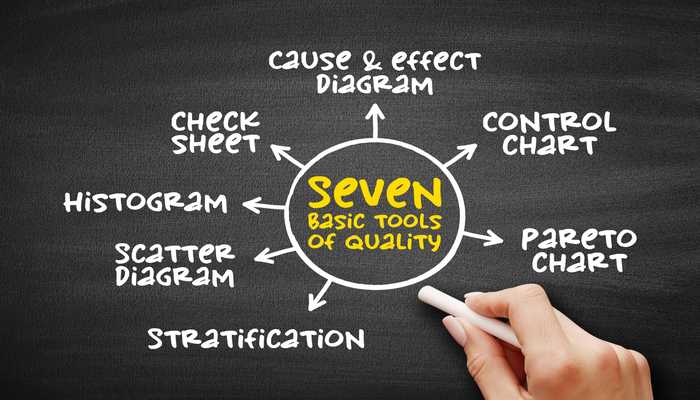Summary: Quality Management (QM) ensures excellence and customer satisfaction through continuous improvement and strategic policies. It has evolved from basic inspections to a data-driven approach, emphasizing Total Quality Management (TQM) principles and preventive measures. Implementing a QMS aligns organizational goals with quality standards like ISO 9001, involving stakeholder engagement and methods like Six Sigma for efficiency and competitive advantage.
What is Quality Management?
Quality management is the act of overseeing all activities and tasks needed to maintain a desired level of excellence. It involves creating and implementing policies and procedures to achieve and maintain quality. Achieving customer satisfaction through products and services is the ultimate goal of quality management. Understanding the fundamentals of quality management is crucial in ensuring that organizations deliver high-quality products and services consistently. It involves a systematic approach to quality that focuses on meeting customer requirements and enhancing their satisfaction. The history of quality management dates back to the early 20th century, with the work of pioneers like Walter Shewhart and W. Edwards Deming. These individuals laid the foundation for modern quality management practices that continue to evolve today. Quality management involves supervising all the activities and tasks required to uphold or reach a specific standard of excellence within your organization. It is comprised of four essential processes: planning for quality, ensuring quality, controlling quality, and continuously improving.
- Quality planning: Outline key processes and metrics
- Quality assurance: Validate capabilities to meet objectives
- Quality control: Inspect and test deliverables
- Continual improvement: Refine processes for better efficiency
History of Quality Management
The history of quality management can be traced back to the early industrial era when experts began focusing on improving production processes to deliver better quality products. Over time, significant figures like Deming and Juran contributed to the development of quality management methodologies.
The evolution of quality management has witnessed shifts from merely inspecting final products for defects to integrating quality into every aspect of business operations. This transition has led to the establishment of various quality standards and frameworks that organizations adhere to in pursuit of excellence.
Modern quality management encompasses a holistic approach that emphasizes continuous improvement, customer focus, and employee engagement. It leverages advanced tools and technologies to drive quality initiatives and ensure the consistent delivery of high-quality products and services.
Modern Quality Management
Modern quality management is characterized by a data-driven approach that relies on statistical tools and analysis to monitor processes and identify areas for improvement. It places a strong emphasis on prevention rather than detection of defects, aiming to eliminate root causes of quality issues. Incorporating principles of total quality management (TQM), modern quality management focuses on creating a culture of quality throughout organizations. It encourages the involvement of all employees in quality improvement initiatives and promotes a proactive approach to addressing quality challenges.
Continuous innovation and adaptation to changing market dynamics are essential aspects of modern quality management. Organizations that embrace a quality-centric culture are better positioned to achieve sustainable growth and maintain a competitive edge in the marketplace.
How to Implement a Quality Management System?
Implementing a quality management system (QMS) requires a strategic approach that aligns with an organization’s objectives and operational requirements. It involves defining quality policies, setting objectives, and establishing processes to achieve and maintain quality standards. An effective approach to quality management involves engaging stakeholders at all levels of the organization to ensure buy-in and support for quality initiatives. This collaborative effort helps create a culture of quality that permeates throughout the organization and drives continuous improvement.
Quality improvement methods such as Six Sigma, Lean Six Sigma, and Kaizen provide structured frameworks for identifying and addressing quality issues within an organization. These methodologies focus on eliminating waste, reducing variation, and enhancing process efficiency to deliver superior products and services.
Want to streamline your quality processes?
Optimize them with EQMS .
Quality Improvement Methods
Quality improvement methods aim to streamline processes, optimize resources, and enhance overall organizational performance. By implementing these methodologies, organizations can systematically identify bottlenecks, improve productivity, and drive innovation to achieve sustainable growth. The integration of quality improvement methods into a QMS enables organizations to systematically monitor and measure performance against established quality objectives. This data-driven approach facilitates data-based decision-making and empowers organizations to drive continuous improvement initiatives effectively.
Implementing quality improvement methods requires a structured approach that involves training employees, establishing clear metrics, and fostering a culture of experimentation and learning. By embedding these principles into the organizational DNA, companies can foster a culture of innovation and excellence.
- Benchmarking
- Continuous Improvement Process
- Statistical Process Control
- Variation Risk Management
- Business Process Re-engineering
- Six Sigma
What are the Key Components of a QMS?
Key components of a quality management system (QMS) include principles that guide organizations in achieving quality objectives and meeting customer requirements. These principles serve as the foundation for establishing a culture of quality within an organization. Quality management software solutions play a crucial role in automating quality processes, facilitating data analysis, and ensuring compliance with quality standards. These tools enable organizations to streamline quality management activities, enhance visibility into quality metrics, and drive informed decision-making.
- Risk assessment tools: Identify potential quality issues early
- Root cause analysis: Pinpoint underlying causes of quality problems
- Performance measurement systems: Track improvements and monitor
- Insights: Provide data for areas needing enhancement
- Opportunities for innovation: Encourage creative improvement solutions
Quality Management Tools
Quality management tools leverage advanced technologies to streamline quality processes, automate repetitive tasks, and enhance collaboration among team members. By integrating these tools into the QMS, organizations can improve operational efficiency, reduce errors, and enhance overall product and service quality. The adoption of quality management software solutions enables organizations to align quality initiatives with business objectives, track progress, and demonstrate compliance with industry standards. These tools empower organizations to drive quality improvements, mitigate risks, and deliver value to customers effectively.
Quality management tools serve as enablers of continuous improvement by providing real-time insights, actionable data, and performance metrics that guide decision-making. By leveraging these tools, organizations can optimize quality management practices and achieve sustainable growth in competitive markets.
Why is Quality Improvement Essential?
Quality improvement is essential for organizations looking to enhance customer satisfaction, drive operational efficiency, and maintain a competitive edge in the marketplace. It involves implementing strategies and initiatives aimed at continually enhancing product and service quality to meet or exceed customer expectations. Implementing quality control measures helps organizations identify and address defects in products or services before they reach customers, ensuring consistent quality and customer satisfaction. By implementing quality planning and assurance processes, organizations can proactively manage quality throughout the product or service lifecycle. Adhering to quality standards and compliance requirements is crucial for organizations operating in regulated industries. By ensuring compliance with industry-specific quality regulations, organizations can demonstrate their commitment to quality, safety, and customer satisfaction.
Quality Standards and Compliance
Quality standards provide organizations with a framework for establishing quality management systems, defining quality metrics, and ensuring compliance with industry best practices. Adhering to quality standards helps organizations benchmark performance, drive continuous improvement, and enhance overall quality culture. Implementing quality assurance processes enables organizations to systematically monitor and evaluate quality performance, identify areas for improvement, and implement corrective actions to enhance quality. Quality assurance activities include quality audits, process reviews, and compliance assessments to ensure adherence to quality standards. Ensuring quality control measures are in place throughout the supply chain is essential for organizations looking to deliver high-quality products and services consistently. By collaborating closely with suppliers and monitoring quality at every stage of the supply chain, organizations can mitigate risks, enhance product quality, and build customer trust.
FAQ | Quality Management
What is quality management?
Quality management is a comprehensive approach that focuses on improving quality by implementing systems, techniques, and standards to meet customer requirements and achieve organizational goals.
What are the principles of ISO in quality management?
The ISO 9000 series outlines principles for quality management, including customer focus, leadership, process approach, improvement, evidence-based decision making, and relationship management.
How can quality management software help businesses?
Quality management software provides tools for effectively managing quality processes, ensuring compliance with standards, analyzing data for improvements, and enhancing overall quality control and quality management.
What is the process approach in quality management?
The process approach in quality management involves identifying, understanding, and managing interrelated processes as a system to achieve desired outcomes and meet quality objectives.
What is the significance of statistical process control in quality management?
Statistical process control is a method used in quality management to monitor and control processes through statistical analysis, identifying variations and ensuring consistency in quality output.
How does top management guide quality initiatives in an organization?
Top management plays a critical role in quality management by setting clear quality policies and objectives, providing resources and support, and leading by example to drive continuous improvement and achieve better quality outcomes.
What are the key methods for quality improvement in quality management?
Quality improvement methods include process improvement, statistical quality control, risk management, and adherence to international standards such as ISO 9001, aimed at enhancing product/service quality and customer satisfaction.
Image: Adobe Stock – Copyright: © Kiattisak – stock.adobe.com





